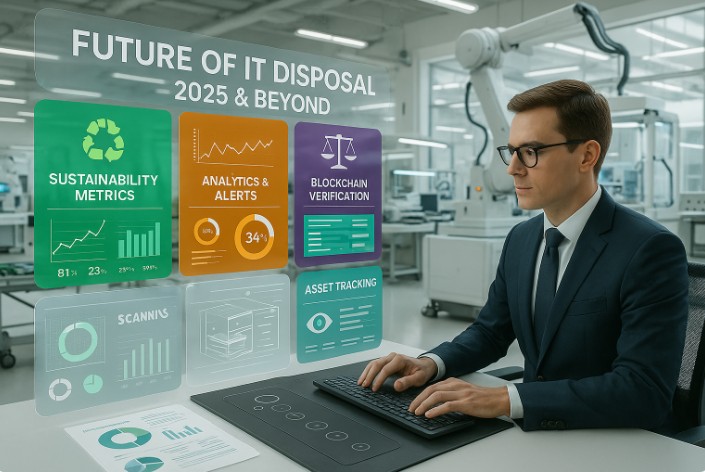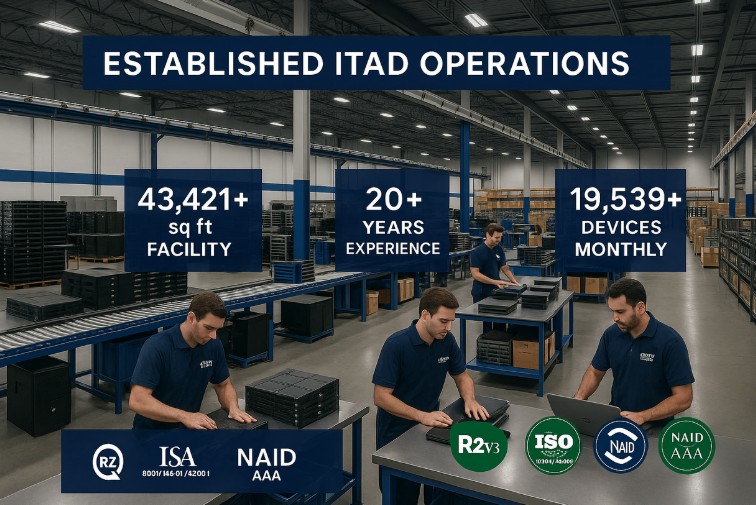When a Fortune 500 financial services company discovered that 40% of its decommissioned servers still contained sensitive customer data despite following standard disposal procedures, it became clear that traditional IT equipment disposal methods are no longer sufficient. According to the World Health Organization, global e-waste generation reached 62 million tons in recent years, with only 22.3% properly collected and recycled, an 82% increase since 2010. As organizations face mounting pressure from regulatory bodies and stakeholders, the future of IT equipment disposal demands revolutionary approaches that prioritize data security, environmental responsibility, and regulatory compliance.
The Importance of IT Equipment Disposal
The landscape of IT equipment disposal is undergoing an unprecedented transformation as organizations grapple with evolving security threats, stringent regulatory requirements, and growing environmental consciousness. Modern enterprises must navigate complex challenges that extend far beyond simple asset retirement, requiring comprehensive strategies that address multiple stakeholder concerns.
Sustainability reporting is now mandatory for nearly 50% of organizations, especially within the EU and ESG-regulated sectors, fundamentally changing how businesses approach IT asset disposition.
Environmental Impact of Improper IT Asset Disposal
The environmental implications of IT equipment disposal have reached critical levels, demanding immediate attention from organizations worldwide. According to research by the Synergy Research Group, global spending on data centre hardware and software grew to $152 billion in 2019.
Environmental challenges include:
- Resource depletion through improper disposal
- Toxic contamination from hazardous substances
- Carbon footprint expansion from inefficient practices
- Landfill overflow contributes to environmental degradation
With 81% of the energy associated with a computer used during production, proper IT hardware disposal offers significant environmental benefits through material recovery.
Security Concerns in IT Equipment Disposal
Data security represents one of the most critical aspects of modern IT equipment disposal, as organizations face escalating threats from cybercriminals. IBM’s Cost of a Data Breach Report reveals that inadequate asset disposal contributes to security incidents.
Security risks include:
- Data breaches from incomplete erasure procedures
- Identity theft through recovered customer data
- Corporate espionage via sensitive configuration files
- Regulatory violations from poor data protection practices
IT Disposal Compliance: RCRA, WEEE, and Global Regulations
Regulatory compliance requirements continue to evolve rapidly, creating complex obligations for organizations disposing of IT equipment. The Resource Conservation and Recovery Act (RCRA) and state-specific e-waste laws establish strict guidelines, while international regulations like the Waste from Electrical and Electronic Equipment (WEEE) Directive impose penalties up to $24 million or 4% of global turnover for non-compliance.
Evolving Trends in IT Equipment Disposal
The IT equipment disposal industry is experiencing rapid transformation driven by technological advancement, regulatory evolution, and changing organizational priorities. These trends are reshaping how organizations approach asset disposition and creating new opportunities for value recovery while addressing environmental and security concerns.
Enhanced Security Protocols
Enhanced security protocols are becoming standard practice as organizations recognize the inadequacy of traditional data destruction methods. The NIST 800-88 Rev.1 standards now require cryptographic erasure and physical destruction for high-security environments, while third-party validation processes provide white-labeled disposal certificates.
Advanced security measures include:
- Multi-pass data wiping using certified data erasure software
- Cryptographic erasure for encrypted storage devices
- Physical destruction of high-security storage media
- Chain of custody documentation throughout the disposal process
- Compliance reports providing audit trails for regulatory requirements
Compliance with New Regulations
New regulations are emerging globally to address the challenges of electronic waste and data protection. Organizations must adapt their disposal practices to meet evolving requirements.
Regulatory developments include:
- Enhanced data protection requirements under privacy legislation
- Extended producer responsibility for electronic equipment manufacturers
- Mandatory sustainability reporting for large organizations
- Stricter e-waste laws governing disposal methods
Advancements in Sustainable Practices
Sustainable practices are becoming integral to IT equipment disposal as organizations embrace environmental, social, and governance (ESG) principles. According to the U.S. Environmental Protection Agency (USEPA), recycling one million cell phones can recover 75 pounds of gold, 772 pounds of silver, 35,000 pounds of copper, and 33 pounds of palladium.
Best Practices for IT Equipment Disposal
Implementing comprehensive best practices for IT equipment disposal requires strategic planning, robust processes, and ongoing monitoring to ensure optimal outcomes across data security, compliance, and environmental dimensions.
Secure Data Destruction Methods
Secure data destruction represents the foundation of effective IT equipment disposal, requiring multiple layers of protection to ensure the complete elimination of sensitive information. Organizations must implement NIST SP 800-88 Rev. 1-compliant procedures that address various storage technologies.
Data destruction methodologies include:
- Software-based wiping using certified erasure software
- Degaussing for magnetic storage media
- Physical destruction through shredding or crushing
- Cryptographic erasure for encrypted devices
Documentation and Chain of Custody
Comprehensive documentation and chain of custody procedures provide essential audit trails for regulatory compliance and risk management. Organizations must maintain detailed records throughout the disposal process.
Documentation requirements include:
- Asset tracking from collection through disposition
- Data erasure certifications providing proof of destruction
- Chain of custody records documenting asset handling
- Compliance reports summarizing disposal activities
Alignment with Standards and Policies
Alignment with industry standards and organizational policies ensures consistent, compliant disposal practices across all IT assets. Organizations must develop comprehensive IT asset disposition policies that address both security requirements and environmental obligations.
The Role of IT Asset Disposition Vendors
Professional IT Asset Disposition (ITAD) vendors play an increasingly critical role in helping organizations navigate IT equipment disposal while maximizing value recovery and ensuring compliance with evolving regulatory requirements and industry standards.
Criteria for Choosing Reputable ITAD Vendors
Selecting reputable ITAD vendors requires careful evaluation of capabilities, certifications, and track records to ensure optimal outcomes for security, compliance, and value recovery objectives.
Vendor selection criteria include:
- Industry certifications, including Responsible Recycling (R2) and ISO 14001
- Security clearances for handling sensitive data
- Insurance coverage that protects your organization from liability in the event of a breach
- Audit capabilities that offer transparent reporting
ITAD’s Role in Supporting the Circular Economy
ITAD vendors are becoming essential partners in implementing circular economy practices that maximize asset value while minimizing environmental impact. According to Globe Newswire, the global ITAD market continues to grow annually, with its size projected to reach $15.9 billion by 2027.
Benefits of Partnering with ITAD Services
Partnering with professional ITAD services provides organizations with specialized expertise, advanced capabilities, and comprehensive solutions that would be difficult to develop internally.
Partnership benefits include:
- Risk mitigation through professional handling
- Cost optimization via value recovery
- Compliance assurance that meets regulatory requirements
- Environmental stewardship that supports sustainability objectives
Sustainability in IT Disposal
Sustainability considerations are becoming increasingly central to IT disposal strategies as organizations recognize their environmental responsibilities and stakeholder expectations for responsible business practices.
Asset Recovery and Value Maximization
Asset recovery and value maximization strategies enable organizations to offset disposal costs while supporting environmental objectives.
Strategies for E-waste Reduction
E-waste reduction strategies focus on extending equipment lifecycles and implementing comprehensive recycling programs.
Enhancing Corporate Reputation through Sustainability
Sustainability initiatives in IT disposal enhance corporate reputation by demonstrating environmental responsibility and commitment to ESG principles.
Challenges and Opportunities in IT Equipment Disposal
The evolving landscape of IT equipment disposal presents both challenges and opportunities for organizations willing to adapt their strategies.
Overcoming Barriers to Adaptation
Organizations must address operational barriers such as budget constraints and technical complexity to implement effective disposal strategies.
Leveraging Opportunities in Regulatory Changes
Regulatory changes create opportunities for organizations to differentiate themselves through superior compliance capabilities and forward-thinking sustainability programs.
The Future of IT Equipment Disposal: Emerging Trends and Global Impact
The future of IT equipment disposal will be shaped by emerging technologies and evolving regulations, requiring organizations to stay agile and proactive in their strategies.
Emerging Technologies in Disposal
Emerging technologies, including artificial intelligence and blockchain, are revolutionizing IT equipment disposal capabilities. These innovations support real-time tracking, predictive asset management, and automated compliance workflows, streamlining the entire disposition process.
The Impact of Global Market Trends on IT Disposal
Global market trends, including digital transformation and sustainability mandates, are reshaping the IT disposal landscape. As more companies adopt circular economy models and sustainability reporting becomes standard, IT asset disposition must align with both operational efficiency and environmental responsibility.
Build a Future-Ready IT Disposal Strategy
As data volumes grow, regulations tighten, and environmental demands intensify, the way organizations manage IT equipment retirement has become a strategic imperative.
By staying ahead of industry trends, partnering with certified ITAD vendors, and embracing sustainable best practices, your organization can ensure secure, compliant, and cost-effective equipment disposal—now and into the future.
Ready to future-proof your IT disposal strategy for 2025 and beyond? Contact OEM Source’s data destruction services to learn how our certified ITAD solutions ensure maximum value recovery, complete data security, and regulatory compliance for your organization’s evolving needs.
Frequently Asked Questions
What are the key trends shaping the future of IT equipment disposal?
Key trends include enhanced security protocols, tightening regulatory compliance requirements, increased adoption of sustainable practices, and the growing role of certified ITAD vendors in providing comprehensive, end-to-end disposal solutions.
How can organizations ensure compliance with evolving regulations?
Organizations can ensure compliance by partnering with certified ITAD vendors, implementing comprehensive documentation procedures, following established standards like NIST 800-88, and maintaining up-to-date knowledge of applicable regulatory requirements.
What role do ITAD vendors play in sustainable IT disposal?
ITAD vendors provide specialized expertise in secure data destruction, asset recovery, environmental compliance, and value maximization while supporting circular economy practices through device refurbishment and responsible electronics recycling programs.
What’s the difference between ITAD and traditional recycling in a long-term strategy?
ITAD focuses on secure data destruction, value recovery, and regulatory compliance—making it ideal for assets with residual value or sensitive data. Traditional recycling emphasizes environmental goals through raw material recovery. For a long-term strategy, a blended approach ensures both risk mitigation and sustainability.
How can companies maximize value recovery from disposed IT equipment?
Companies can maximize value recovery by partnering with reputable ITAD vendors, implementing robust asset tracking systems, timing disposal strategically, and leveraging refurbishment opportunities through OEM Source’s comprehensive services.





